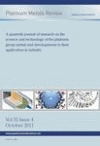-
oa Ruthenium Enhanced Titanium Alloys
Minor Ruthenium Additions Produce Cost Effective Corrosion Resistant Commercial Titanium Alloys
- Source: Platinum Metals Review, Volume 40, Issue 2, Apr 1996, p. 54 - 61
-
- 01 Jan 1996
Abstract
Several new, more highly corrosion resistant titanium alloys containing a nominal 0.1 weight per cent of ruthenium have been developed and evaluated for industrial service in corrosive environments. These improved ruthenium-enhanced α, α-β and β titanium alloys are lower in cost than the corresponding palladium-containing titanium alloys, and offer essentially the same corrosion performance in dilute reducing acids and hot brine environments. The titanium-0.1 ruthenium binary alloys can be cost effectively substituted for traditional titanium-palladium alloys and should represent a more attractive alternative to nickel-chromium-molybdenum alloys in hot, acidic brine applications. The corrosion database that has been established for the higher strength ruthenium-enhanced α-β and β titanium alloys in high temperature sweet and sour brines provides the basis for their selection for applications in the chemical process, oil/gas production, offshore and geothermal energy industries.


